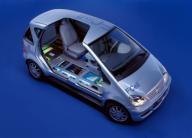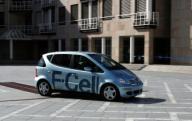LA AUTO SHOW: Mercedes-Benz F-Cell Makes Fuel Cell Power a Reality
 |
 |
UPS Will Be The First Corporate F-Cell Customer In The U.S.
LOS ANGELES, Dec. 30 -- Mercedes-Benz is displaying the latest DaimlerChrysler fuel cell vehicle at the L.A. Auto Show, January 4-11 in the Los Angeles Convention Center. Based on the Mercedes-Benz A-Class model currently sold abroad, the "F-Cell" fuel cell vehicle is fueled by compressed hydrogen. UPS , along with other corporate and municipal customers, will lease a significant number of "F-Cell" test cars in the U.S. over the coming year.
During 2004, the F-Cell fleet in the U.S. will expand gradually in three areas -- Detroit, MI; Sacramento, CA and Los Angeles. DaimlerChrysler has emissions testing facilities near L.A. and Detroit, and the California Fuel Cell Partnership is based in Sacramento. The Partnership brings together the auto industry, government and oil companies in an effort to develop fuel-cell technology and address the infrastructure issue.
What's A Fuel Cell?
Fuel-cell cars are electric vehicles that make their own electric power on board instead of relying on batteries. Fuel cells are considered the cleanest and most promising propulsion system for the future. In 1994, Mercedes-Benz became the first car company to debut a fuel cell vehicle, and last year its NECAR 5 became the first fuel-cell car to successfully complete a coast-to-coast trip from San Francisco to Washington, D.C.
In a fuel cell, hydrogen gas flows along one side of a special membrane, and air flows along the other side. The PEM (for proton exchange membrane) allows hydrogen and oxygen to combine without combustion, creating electric current instead of producing high heat. Fuel cells are significantly more efficient than combustion engines, and most important, the only exhaust produced is water.
The Mercedes-Benz F-Cell fleet represents a next step in the production of zero-emission vehicles. The hydrogen-powered F-Cell cars are being built in conventional manufacturing facilities and will be tested by corporate and municipal customers for feedback in "everyday-use" situations.
While the development of automotive fuel cells has made enormous progress in the past few years, some major challenges still remain. The cost of fuel- cell vehicles must be reduced to compete with conventional engine technology, while the production of hydrogen fuel and development of a refueling infrastructure needs to be established and standardized.
"Fuel cell technology gives us the opportunity to bring mobility together with environmental compatibility and make a major contribution to society," says Professor Juergen Hubbert, DaimlerChrysler AG board member in charge of the Mercedes-Benz, Maybach and smart passenger car division. "To enable the fuel cell to go on the market in the foreseeable future, most importantly the fuel and infrastructure issues must be clarified in a worldwide initiative, jointly with the political community, the mineral oil industry and the energy sector. Development engineers, too, still face numerous challenges, referring mainly to the further reduction of weight and cost as well as the improvement of reliability and durability. In this field, manufacturers should cooperate more intensively so as to promote the breakthrough of this key technology."
Sandwich Floor Hides A Fuel Cell Stack
In the F-Cell, the entire fuel-cell system is housed between the bi-level "sandwich" floors of the A-Class, a compact Mercedes-Benz model not yet sold in the U.S. As a result, all the cargo- and people-carrying features of the surprisingly spacious five-passenger car are preserved. The fuel cell -- actually a stack of PEM membranes -- is supplied by tanks of hydrogen that are compressed to around 5000 pounds per square inch. Its electric motor produces 65 kilowatts, which translates to about 155 ft.-lb. of torque and 87 horsepower.
Since the debut of the first NECAR vehicle in 1994, DaimlerChrysler AG has developed more than 20 concept vehicles utilizing fuel cell technology. Each time, the size and weight of the system was reduced, while its power, efficiency and performance were improved. About 30 fuel-cell Citaro buses are already serving ten European cities, and 60 Mercedes-Benz A-Class F-Cell vehicles will be on the road by the end of 2004.


